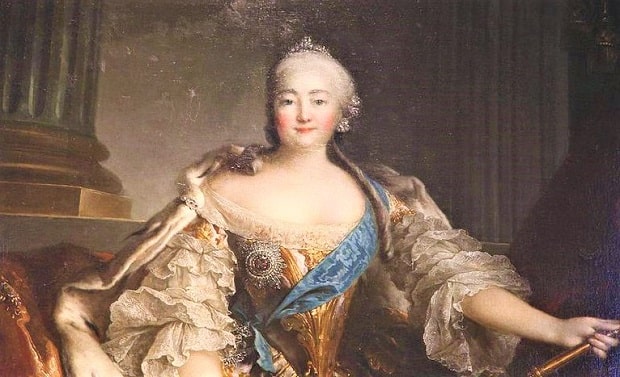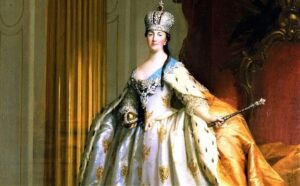
Catherine the Great (Born on May 2, 1729, in Szczecin, Germany (today Poland) – Died on November 17, 1796, in Saint Petersburg, Russia), was also known as Catherine II, was the Empress of Russia from 1762 until his death. She was the country’s longest-ruling female leader.
She was the elder daughter of Prince Anhalt-Zerbst and Joanna Elisabeth of Holstein-Gottorp, Catherine came to power as a result of a palace coup that overthrew her unpopular husband Peter III from the throne. The Catherine era was marked by the maximum slavery of the peasants and the comprehensive expansion of the privileges of the nobility.
During his reign, the Russian Empire improved its administration and continued to modernize. Catherine’s reign revitalized Russia, which grew even more strongly and became known as one of the greatest European powers.
Quick Facts: Catherine The Great
- Born: May 2, 1729, in Szczecin, Germany (today Szczecin, Poland)
- Known for: Empress of Russia
- Also known As: Catherine II
- Reign: 9 July 1762 – 17 November 1796
- Coronation: 22 September 1762
- Predecessor: Peter III
- Successor: Paul I
- Parents: Father – Christian August, Prince of Anhalt-Zerbst, Mother – Princess Johanna Elisabeth of Holstein-Gottorp
- Religion: Russian Orthodox (1744–1796), prev. Lutheran (1729–1744)
- House: Holstein-Gottorp-Romanov (by marriage), Ascania (by birth)
- Spouse: Peter III of Russia (m. 1745; died 1762)
- Died: 17 November 1796 (aged 67) Winter Palace, Saint Petersburg, Russian Empire
- Burial: Peter and Paul Cathedral in Saint Petersburg
Early Life of Catherine The Great
Sofia Federica Augusta von Anhalt-Zerbst, better known as Catherine the Great, was born on April 21, 1729, in Stettin, Prussia. She was the daughter of Christian Augustus, prince of Anhalt -Zerbst, a minor member of German royalty, and her mother was Joanna Elizabeth of Holstein-Gottorp.

Little Sofia’s father was a Prussian general and governor of the city where the family was based: Stettin. On the maternal side, she was related to Gustavo III and Carlos XIII of Sweden. The education of the young woman was in charge of French tutors and governesses, considered at the time the highest and most refined of European culture.
Little else is known about the early years of the future Catherine the Great, but it was at this time that her love of Western-style knowledge and the philosophers of the Enlightenment developed whom she always held in high esteem and which was a voracious reader.
Education
For the Russian empress, the educational issue was of utmost importance. She was immersed in the postulates of the enlightened philosophers, which at first made her believe that she could improve the government if she managed to raise the intellectual level of the citizens.
He consulted with British educators such as Daniel Dumaresq, whom he named part of the Education Commission which addressed the educational reforms that were necessary for the country. Like many other Catalina reform projects, the suggestions of this commission were not implemented.
However, Catherine II did concern herself with creating new educational institutions aimed at both females and males. During her reign, the first Russian orphanage was created in the city of Moscow, but it failed. The first Russian girls’ school was also born in the days of Catherine the Great.
Both noble and bourgeois youth were admitted to the academy and it was called the “Smolny Institute”. Another of the efforts that Catherine tried to make in favor of Russian academic instruction in 1786 was the National Education Statute.
In said decree she ordered that public schools be created in the main cities, they were to admit young people of any social class, except serfs. The results of that experiment were not encouraging at all since the bulk of the population preferred to send their children to private institutions and the numbers of young people benefiting from the plan were very low.
Marriage With Peter III
She met her future husband, the Grand Duke Peter (later known as Peter III), on a trip to Russia at the invitation of Empress Elisabeth, Peter Tante, who rules Russia after turning on in a coup. Elizabeth, single and childless, had named Peter as her heir to the Russian throne.
Peter, although the Romanov legacy, was a German prince. His mother was Anna, the daughter of Peter the Great of Russia, and his father was the Duke of Holstein-Gottorp. Peter the Great had 14 children, survived by his two wives, only three of them until adulthood. His son Alexei died in prison, sentenced to fall from his father’s graph.
His older daughter Anna was the mother of Grand Duke Peter, who married Catherine. Anna died in 1728 after the birth of her only son, a few years after the death of her father, and while her mother Catherine I was ruled by Russia.
Catherine the Great (or Catherine II) converted Orthodoxy, changed her name, and married the Grand Duke Peter in 1745. Although Catherine had the support of Peter’s mother, Empress Elisabeth, she liked her husband-Catherine later wrote that she had been more interested in the crown as the person, and first Peter and then Catherine was unfaithful.
Her first son Paul, later emperor (or czar) of Russia as Paul I, was born nine years in the marriage, and some questioned whether his father was Catherine’s husband. Her second child, daughter Anna, was probably conceived by Stanislaw Poniatowski. Her youngest child Alexei was most likely the son of Grigory Orlov
Coronation of Catherine The Great
When Tsarina Elizabeth died at the end of 1761, Peter became ruler when Peter III and Catherine became the empress’s wife. She kept on escaping how many thought Peter would divorce her, but Peter’s actions as emperor soon led to a coup against him.
Catherine II of Russia was crowned on September 22, 1762, in Moscow. During a pompous and luxurious ceremony, the Russian Empire celebrated the rise of its new ruler. From that event emerged some of the most important family heirlooms that members of the Romanov dynasty made use of until the end of their existence, such as the Russian imperial crown.
Although Catherine did not belong to the Romanovs by blood, she was a descendant of the Rurik dynasty, one of the oldest royal houses in Russia and the founders of the Tsarist system. Unlike Peter III, Catherine the Great gave herself totally to her nation and put Russia’s interests first.
I felt a sincere desire to transform the Empire, a power prosperous, and advanced was at the level of the best European countries. Finding himself in such a fragile position he decided to maintain a peaceful relationship with Prussia and Frederick the Great.
In 1764 he sent Stanisław August Poniatowski to Poland asking, who had been one of his lovers and who had great respect for Catherine. Poland was divided between Prussia, Russia, and Austria three times: the first was in 1772, the second in 1793 (without Austria), and the third in 1795. This was how these countries eliminated the possibility of Poland emerging as a regional power.
Russian-Turkish War
Catherine II’s perfect excuse to continue the Russian legal and political system without taking into account the reforms proposed by her commission was the conflict that broke out in 1768 between the Russian and Ottoman Empire.
For different reasons, mainly geographical, the Ottomans had taken the role of natural enemies of Russia. The new monarch wanted to return the national gaze to a single objective and to achieve this she chose an issue that was relevant to the entire population: the greatness of Russia.
According to historical records, a group of Russian Cossacks followed Polish rebels to Balta, which was part of the Crimean khanate. Supposedly a terrible massacre was carried out in the city that cried out for the help of its protector, the sultan Mustafá III.
Although the Russians denied the accusations made against him, the Ottomans decided to declare war on him in defense of the Crimean khanate. What Mustafa III did not count on was that Russia was going to dominate on the military plane. Krakow was captured by Catherine II’s army.
Furthermore, in 1770 the Russian fleet arrived in southern Greece and this caused the Ottoman forces to stray and neglect Ukraine. In the Battle of Chesma, the Russians destroyed the Turkish fleet, while in the Battle of Kagul they occupied the Turkish fortresses in Ottoman Ukraine.
Catherine The Great Religion
Although at first, Catherine the Great moved the Russians with their conversion to the Orthodox Church, that was no more than a simple tribute to their subjects. In fact, it did not favor this faith at all, on the contrary, it expropriated the lands of the Church to which it practically nationalized.
He closed more than half of the monasteries and administered the finances of the Church at the convenience of the State. She also decided to remove religion from the formal academic education of young people, which translated into the first step of Russian secularization.
Death of Catherine The Great
Catherine the Great died on November 17, 1796, in Saint Petersburg, Russia. The day before her death, she had woken up in good spirits and claimed to have spent a wonderful night’s sleep. After starting her daily work, she was found on the floor and with a very low pulse.
The doctor diagnosed a stroke, since then he was in a coma and died hours later. Another concern that haunted Catherine’s mind in her final days was the succession of the Russian crown. She did not consider that her son Paul I of Russia was a worthy heir since she observed in her the same weaknesses that Peter III had shown.
Catherine the Great had prepared everything for the son of Paul, Alexander, to be named successor, but because of the precipitate death of the sovereign, this act was not carried out and Paul was the next emperor of Russia.
[…] Successor: Catherine I […]
[…] successor, Empress Catherine II, continued some of these decisions but revoked some of them. It is still debated whether Peter III […]